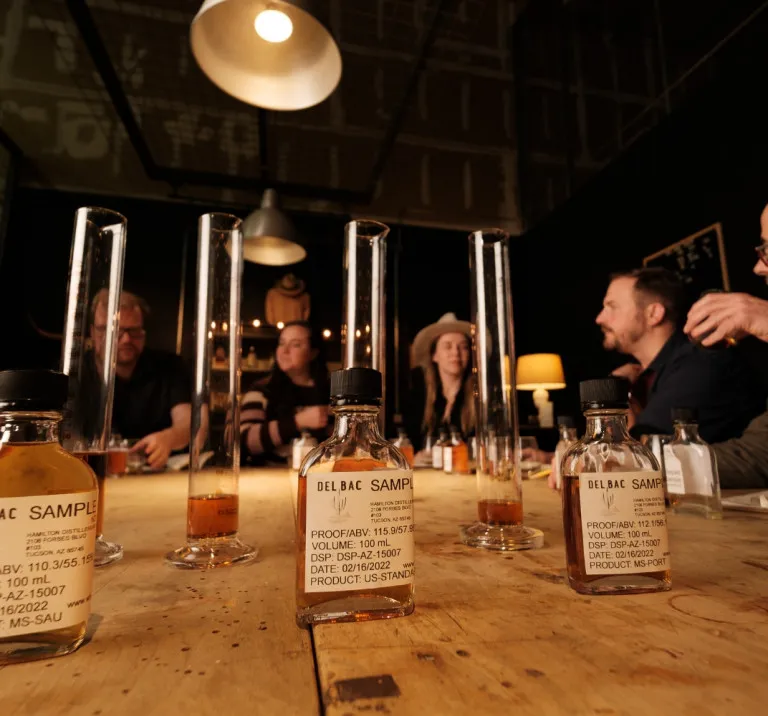Independent bottling has a long, rich, even integral place in the history of Scotch whisky. An independent bottler is someone who purchases whisky distilled by someone else and bottles it under their own label.
But, until recently, Independent Bottlers (IBs) were almost exclusively the provenance of Scotch whisky. Fortunately for whiskey aficionados, that status has changed over the last few years, with more and more IBs releasing whiskies from around the world.
I recently spoke with Nora Ganley-Roper of Lost Lantern Whiskey, the first independent bottler focusing exclusively on the gamut of American whiskey. She is a true leader in this new wave of non-Scotch independent bottlers.
Jammin’ at Jeptha: Jeptha Creed Distillery – Shelbyville, Kentucky
Jeptha Creed’s summer concert series is coming back to the Shelbyville, Kentucky distillery. The events will feature music, food, games, and craft cocktails at the bar.
“Jammin’ at Jeptha” will take place on two dates this year:

Lost Lantern applies the Scotch model of independent bottling to exclusively American whiskies. When you first decided to form a whisky company, how did you settle on that paradigm?
Both Adam and I have loved Scottish independent bottlers for years and, before we decided to start Lost Lantern, we would often discuss how much we wished someone would apply that model to the American whisky space. There are over 2,600 distilleries across the US and an independent bottler could help whiskey lovers find the best whiskey being made. Our conversation eventually evolved from how we wished something like that existed, to how we were the right people to make it happen.
It’s no understatement to say that in applying the Scotch independent bottling model to American whisky, you developed a new market segment. How have you seen that segment grow since you started, both with Lost Lantern and with other companies following your lead? In Scotland the independent bottling world is one of friendly competition, even to the point of swapping casks. What is your relationship with some of the newer companies replicating your model?
We have been so lucky with our early customers and all of the media coverage we have gotten in the first few years. There was certainly a core group of whiskey lovers and journalists that were waiting for someone to do what we are doing! So, that very much helped with our initial launch into the market. We still have a lot of work education-wise so we have been very happy to see additional Independent Bottlers join us in the space.
So far, our relationship with other IBs has been very friendly — both with those that focus entirely on American whiskey and those that have American whiskey as a component of their overall offering, like Single Cask Nation. We’ve even had some great conversations with Scottish I.B.s like Blackadder, who have been very friendly. There is very much a “rising tide lifts all boats” mentality.

The story of how you spent the better part of a year driving cross-country visiting distilleries is well-documented, including in this publication. How many of those distilleries have you worked with to date? Are there others from that trip with whom you plan to work, and/or are you still auditioning new distilleries? Have some of those bourbon and rye distilleries who were at first reluctant to work with you due to their unfamiliarity with independent bottling since “come around” to reach back out due to your success?
Counting our upcoming summer 2024 release, we have released whiskey from 36 distilleries in two dozen states and that number will continue growing! Around 20 of those are places we visited on our initial cross-country road trip pre-pandemic.
We want Lost Lantern to be a reflection of the growing and expanding American whiskey landscape. And we visit every distillery we work with, so that means Adam is on the road a lot these days.
With any of our trips, including our initial eight-month road trip, we have target distilleries in mind which we think are likely ready for us now. We build our travel around those. But, there’s also a second layer of distilleries that we visit — these are a combination of distilleries we don’t know enough about to know if they’re a fit, and distilleries that seem young and promising (and we want to know what they’re up to in the early days)!
So, we’re continuing to explore, add distilleries to our program, and add distilleries to our list of places to keep an eye on!
And yes, we’ve now released whiskies from a couple of distilleries who were initially a bit wary of our model. Now that we have a track record of releases and doing the distilleries we work with justice, they have come around and are excited about working with us! At the same time, some distilleries that we visited on our road trip that weren’t ready for us at the time, have since fully-blossomed and we’ve been thrilled to work with them.
Having sampled a wide spectrum of your whiskies, I described your bottlings as a Master Class in American whiskey. For those unfamiliar, could you describe the different categories, the labeling system, and your various goals with each?
We release on a seasonal basis. All of our collections have a theme that is either focused on a region, a style of whiskey, or another emerging trend that we want to highlight. For instance, spring 2024 was the Midwest Collection.
Lost Lantern presents its distillery partners in three different ways:
- Single Cask Series: a unique barrel presented exactly as the distillery made it, always cask strength and non-chill-filtered. We showcase a lesser known distillery or show a new side of a more well-known distillery.
- Single Distillery Series: A blend we make from multiple barrels of one distillery’s whiskey to showcase the Lost Lantern lens on that distillery.
- Blend Series: Our flagship series. A multi-distillery blend that highlights a style, flavor profile, or region.
Our color scheme:
- Blue: Blend Series
- Red: Bourbon
- Brown: Single Malt
- Green: Rye
- Cream: Innovative
- Yellow: Very Special (we’ve only released one whiskey in this color so far!)






From the outside looking in, your relationships with many of the distilleries with whom you work seem to take on elements of partnerships, much more so than your Scottish counterparts. Would you agree with that assessment, and would you care to elaborate? What advantages does having such relationships provide you?
Yes, I agree wholeheartedly! We believe this so much that we actually call them our distillery partners.
We are lucky to be able to work with distilleries so closely. And, this closeness is also why we’re able to do what we want to do at Lost Lantern. In order for us to do their whiskey justice, we need to understand the people, their choices in the production process, and how the climate impacts what they do. This deep understanding and connection to the people allows us to tell their story and explain why they’re doing something so special.
Also, in the early days of this model, so much of what we do requires trust. Trust from whiskey drinkers, but especially trust from whiskey makers. We’re putting their brand on our bottle and they have to trust that we won’t harm what they are doing! So it’s just as important that they get to know us and understand who we are and what we’re all about.
I know that you have a background in wine. Do you have any plans to experiment with unique wine finishes, either in-house or working directly with the distilleries?
We have a lot of fun plans under way for finishes in-house, especially now that we have our own warehouse and blending facility in Vermont! I can’t share details at this point. That said, we have done a number of wine finishes that had already been done by the distilleries. We’ve released a Westward American Single Malt from Oregon, finished in an Oregon Chardonnay cask; a Westland American Single Malt from Washington, finished in a Washington Cabernet Sauvignon cask; and even a Dad’s Hat Pennsylvania rye, finished in a Vermouth cask.

As a company that really understands the gamut of American whiskey, what are your thoughts of the state of the industry and its many different sub-genres, from bourbon to rye to American Single Malt, and even lesser-known segments? What is on the horizon, how do you see American whiskey’s growth proceeding, and how do you see it progressing on the world whiskey stage?
I think it’s really special and also totally overwhelming! The innovation in American whiskey is pushing in so many different directions all at the same time. Distilleries are playing with finishes, barrel sizes, where they source their grain, how and when they malt their grain, what still they use, how and how long they ferment, etc. It’s truly endless. And there are so many distilleries doing this all at the same time, big and small. That’s the beauty and the curse of American whiskey! And that is exactly why I think we need a range of American Independent Bottlers. We need multiple perspectives looking at what is happening and curating a lineup of what they deem the best. This creates guideposts for whiskey drinkers in their own journeys, both domestically and especially when international drinkers are trying to explore.
I’m particularly excited about the future of American Single Malt. This is a young style of whiskey: the first American Single Malt we know of, McCarthy’s, was first released in the 1990s. But the vast majority of producers have opened since 2010. Yet many of these producers have begun producing amazing and inventive whiskies that push the boundaries of what single malt can be. Places like Whiskey Del Bac in Arizona, which mesquite-smokes their malted barley, or Westland and Copperworks in the Pacific Northwest, which experiment heavily with grain, are some of our favorite examples. Most whiskey drinkers aren’t that familiar with American Single Malt yet, and we think they’ll be very excited as they start to discover it.

How do you see the relatively immediate future for both Lost Lantern and independent bottling in general, and what would you like to see happen long term? Any sneak peeks as to what you have coming up?
We plan to continue to put out whiskey that highlights why this is such an exciting time in American whiskey! We’re planning to add one additional market (beyond California and NY, which we already have) this year and hope to continue to reach more and more whiskey drinkers. Within a few years, I expect we will start exploring export markets, especially in Europe and parts of Asia where independent bottlers are much more familiar to whiskey lovers than they are in the U.S.
I am also hoping that we continue to see more American Independent Bottlers starting up as we need more voices in the chorus!
And most importantly, I hope that American whiskey drinkers continue to be open to exploration and finding new distilleries and flavors to get excited about!
Any last thoughts?
Not that I can think of!
For a deeper explanation and to understand the history of independent bottling, please read my articles:
– “Independent Bottling: A Primer
https://whiskeynetwork.net/2024/02/independent-bottling-a-primer/
and “Independent Bottling: A Brief History”
https://whiskeynetwork.net/2024/03/independent-bottling-a-brief-history-part-1/





